TS
boleroes11
Amphibious Ships Dock Rotterdam & Galicia. (The Netherlands & Spain)
Amphibious ships docks Rotterdam and Galicia (the Netherlands and Spain)
Spain and the Netherlands several centuries ago were the leading naval powers, but later lost his power. However, they have not lost the desire to develop its naval forces. In the late eighties the two countries agreed on the joint development of new ships for the Navy. In a joint project was supposed to create a promising landing ship dock that meets the navies of the two countries.
Joint project
In developing amphibious ships for the Navy of the Netherlands and Spain comply with the requirements of both parties. While the ships were to have some differences due to the characteristics of their future service and wishes naval command. As a result, despite the common "roots", landing craft docks naval forces of the Netherlands and Spain are markedly different from each other. The names head ships Dutch project was designated Rotterdam-class, Spanish - Galicia-class.
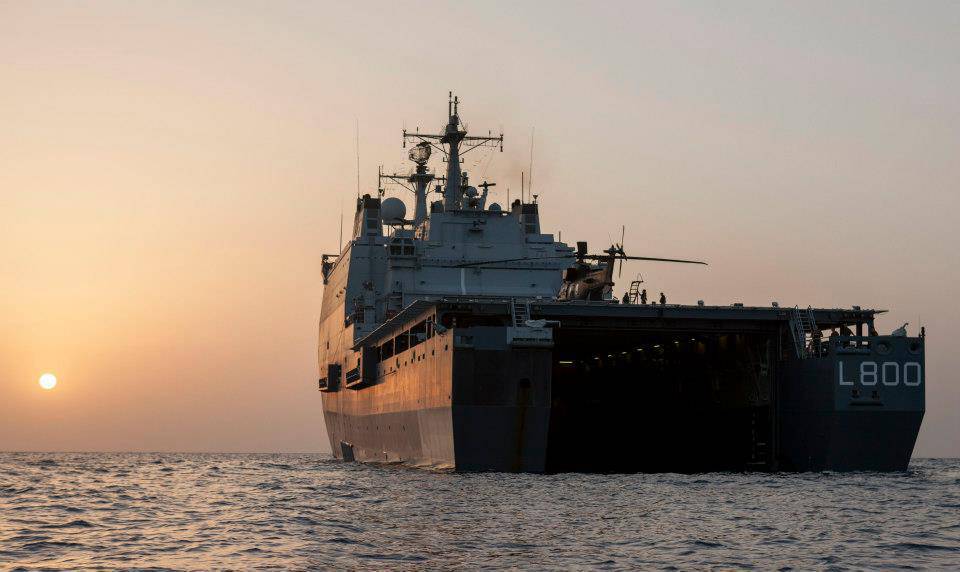
HNLMS Rotterdam (L800)

SPS Galicia (L51)
Construction head ships two projects - HNLMS Rotterdam (L800) for the Netherlands and the SPS Galicia (L51) for Spain - started in the shipyards of the two countries in 1996. Work on the construction came with a fairly high pace and by the middle of 1997, the ships were launched. About a year after it completed testing and leading ships were admitted to the Navy two countries.
The main task of ships of Rotterdam and Galicia is the transportation of troops and providing amphibious landings, with associated basic features of their appearance. All ships built in the framework of the joint project, have a similar layout. Middle and aft of the hull given for placing large docking camera, intended for the carriage of amphibious armored vehicles and landing craft. Large box-shaped superstructure shifted toward the bow. Average and aft deck brought to court for takeoff and landing of helicopters.
Dimensions docking camera, cargo decks and Kubrick lets you carry and provide the-horizon landing battalion of marines with combat and auxiliary equipment. When fully loaded ship HNLMS Rotterdam (L800) is able to carry up to 33 main tanks or armored personnel carriers 170. When transporting a battalion of marines food supplies enough for 10 days of travel.
HNLMS Rotterdam (L800)
Head-dock landing ship for the Royal Netherlands Navy HNLMS Rotterdam (L800) was built on the original project, because of what has smaller dimensions and displacement compared to the next HNLMS Johan de Witt (L801). Ship "Rotterdam" has a length of 166 meters and a maximum width of 25 m Draft - 5.8 meters. Normal displacement of the ship - 12750 tons.
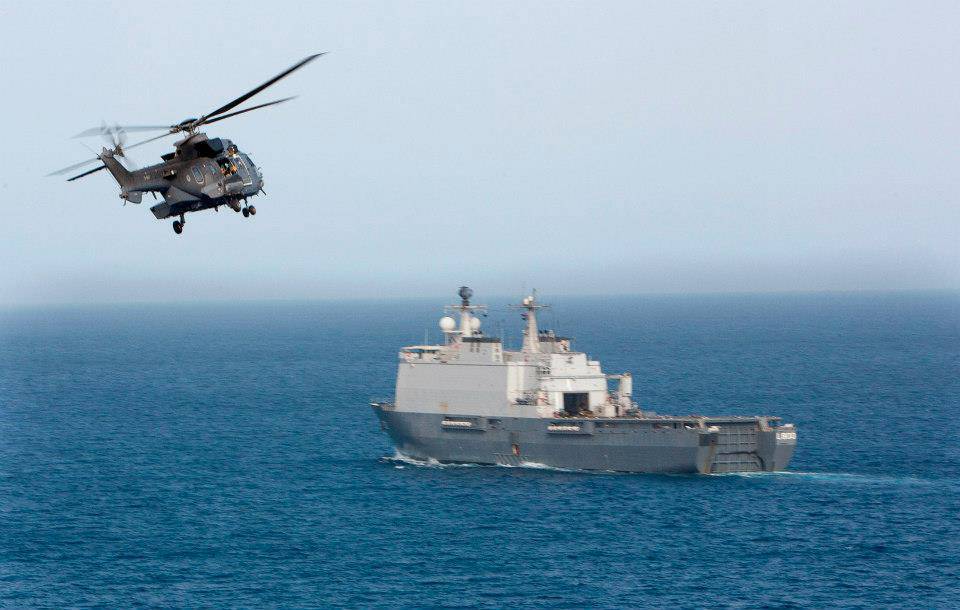
Ship HNLMS Rotterdam (L800) equipped with a combined diesel-electric propulsion. The basis of the power plant are four diesel generator Stork Wärtsilä 12SW28 total capacity of 14.6 MW. Electricity generators supplied by four electric motors with a total capacity of 12 MW. The motors are connected with two propellers, two on each screw. In the bow of the ship has thruster. Such a propulsion system enables amphibious ships of speeds up to 19 knots. Cruising range at economic speed of 12 knots - 6000 miles.
Crew consists of 128 people. In addition, the cockpit for the landing can accommodate more than 600 Marines.
Marine transportation and technology define the layout of the ship. Aft deck are used for takeoff and landing of helicopters. The landing site has dimensions 56h25 meters. There hangar area of 510 square meters. m, designed to carry helicopters. Ship "Rotterdam" can carry and provide work six or four NH90 helicopters EH-101.
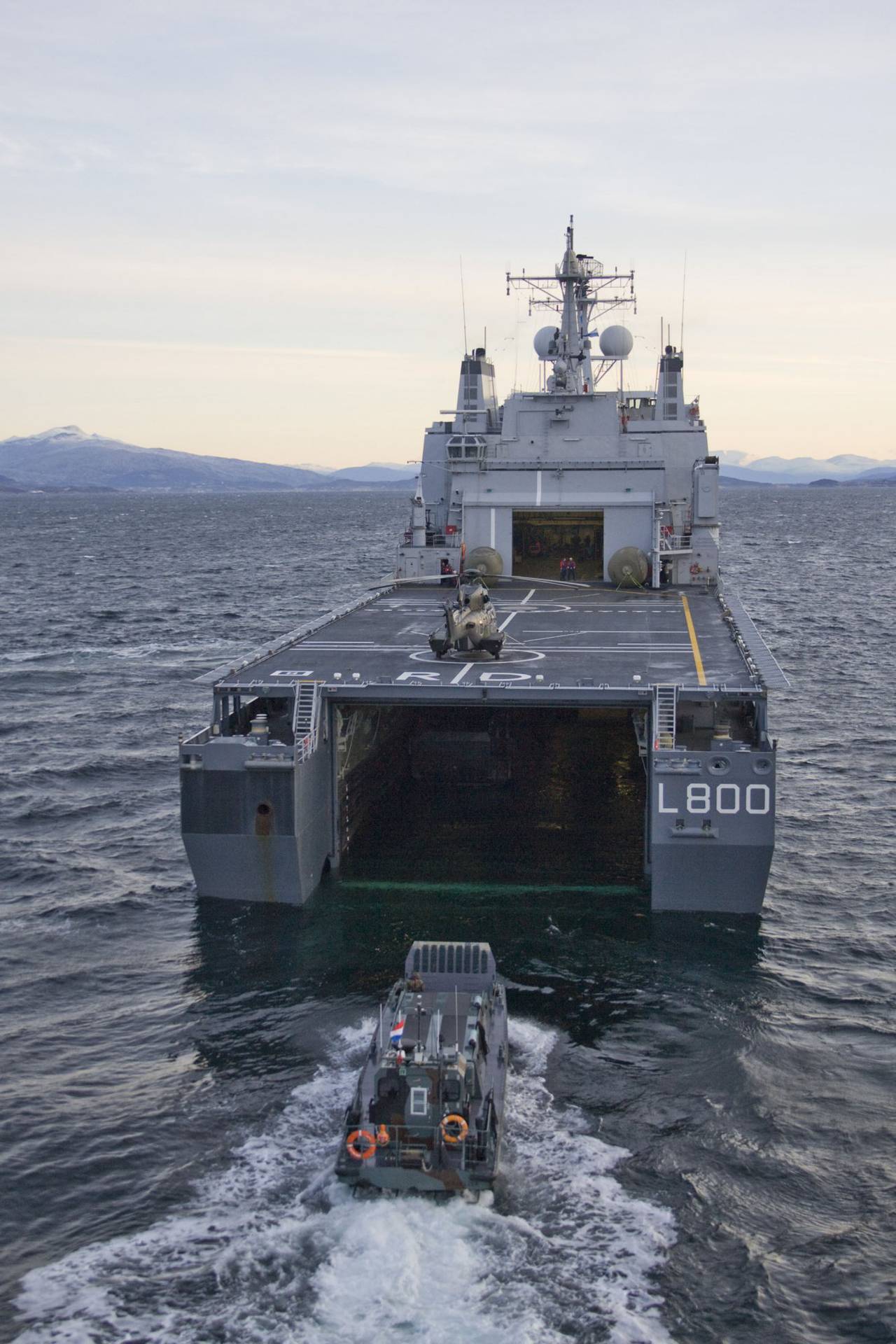
Dock camera in the aft hull has a total area of 921 square meters. m This allows you to carry up to six landing craft LCU Mk.II or four LCVP. For transportation of armored vehicles and other equipment ship HNLMS Rotterdam (L800) has a private deck area of 903 square meters. m If necessary, this amphibious assault ship can carry more than 30 tanks and armored personnel carriers to 170.
Dock landing ship "Rotterdam" is solely a defensive weapon. This two anti-aircraft artillery Thales Netherland SGE-30 Goalkeeper 30 mm caliber and four 20-mm automatic cannon Oerlikon.
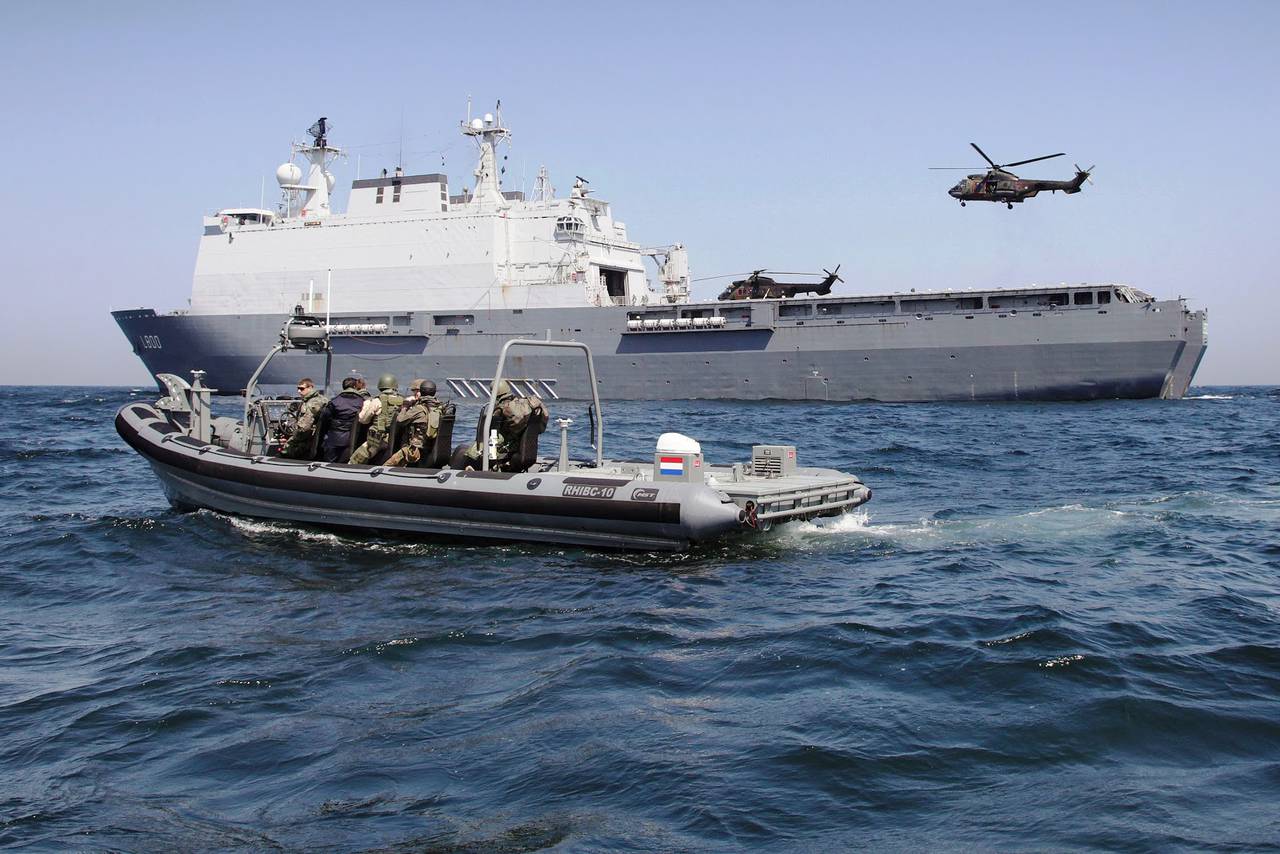
Bookmark ship HNLMS Rotterdam (L800) was held in late January 1996 at the shipyard in Vlissingen KMS. The ship was launched in the end of February 97th, and in April 1998 became a member of the Royal Netherlands Navy. Since then the ship has participated in various exercises and operations. For example, in spring 2004 the Dutch sailors took part in humanitarian operations in Liberia.
HNLMS Johan de Witt (L801)
During the first few years of service, the lead ship of the project Rotterdam used not only for combat training missions, but also to gain experience operating the new amphibious ships. According to the results of the first years of operation, the fleet command made adjustments to the list of requirements for prospective ships of this class. In June 2003, the ceremony of laying the second ship dock, which proposes to build on the updated project.
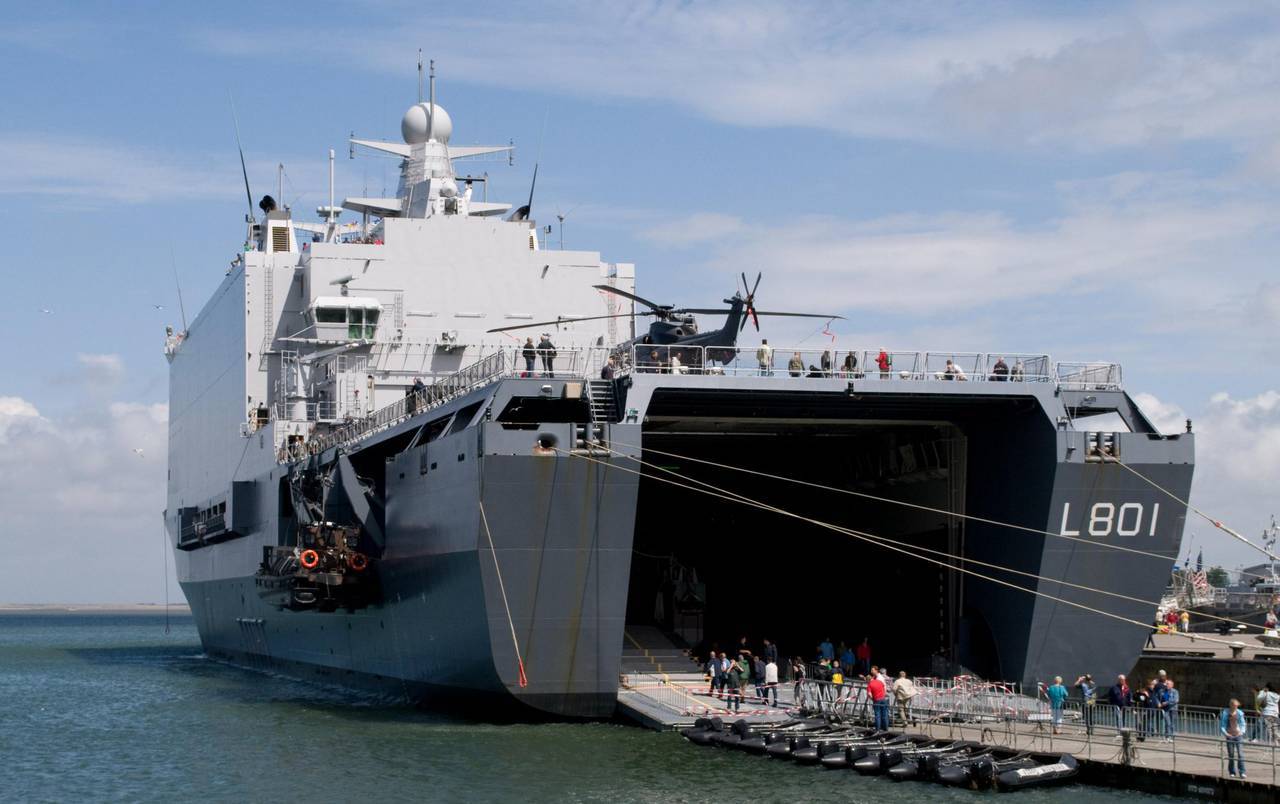
The most visible change was the increase in project size and tonnage of the ship. HNLMS Johan de Witt (L801) has a length of 176 meters and a maximum width of 29.2 meters. Precipitate thus decreased to 5.55 m Full displacement increased to 16,680 tons. In connection with the use of new equipment the crew was increased from 128 to 146 people.
The basis of the power plant in the updated draft stayed four diesel generators. Instead of electric motors, two rotating propellers, it was decided to use two azimuth thrusters with motors of 5.5 MW. Thruster in the bow of the ship remained the same. Increase in the size and characteristics of the displacement was compensated updated powerplant. Ship "Johan de Witt" is capable of speeds up to 19.5 knots. Cruising range remained at the lead ship of the project.
Significant changes were made to the deck designed to carry payloads. Despite the increase in the size of the ship, Kubrick for the Marine Corps were reduced. HNLMS Johan de Witt (L801) is capable of carrying not more than 550 fighters with weapons. Dimensions of the flight deck of the new ship increased to 58h25 meters. At the same time were increased hangar whose area is 600 square meters. m It should be noted, as the lead ship of the project, "Johan de Witt" can carry only six medium helicopters or four heavy.
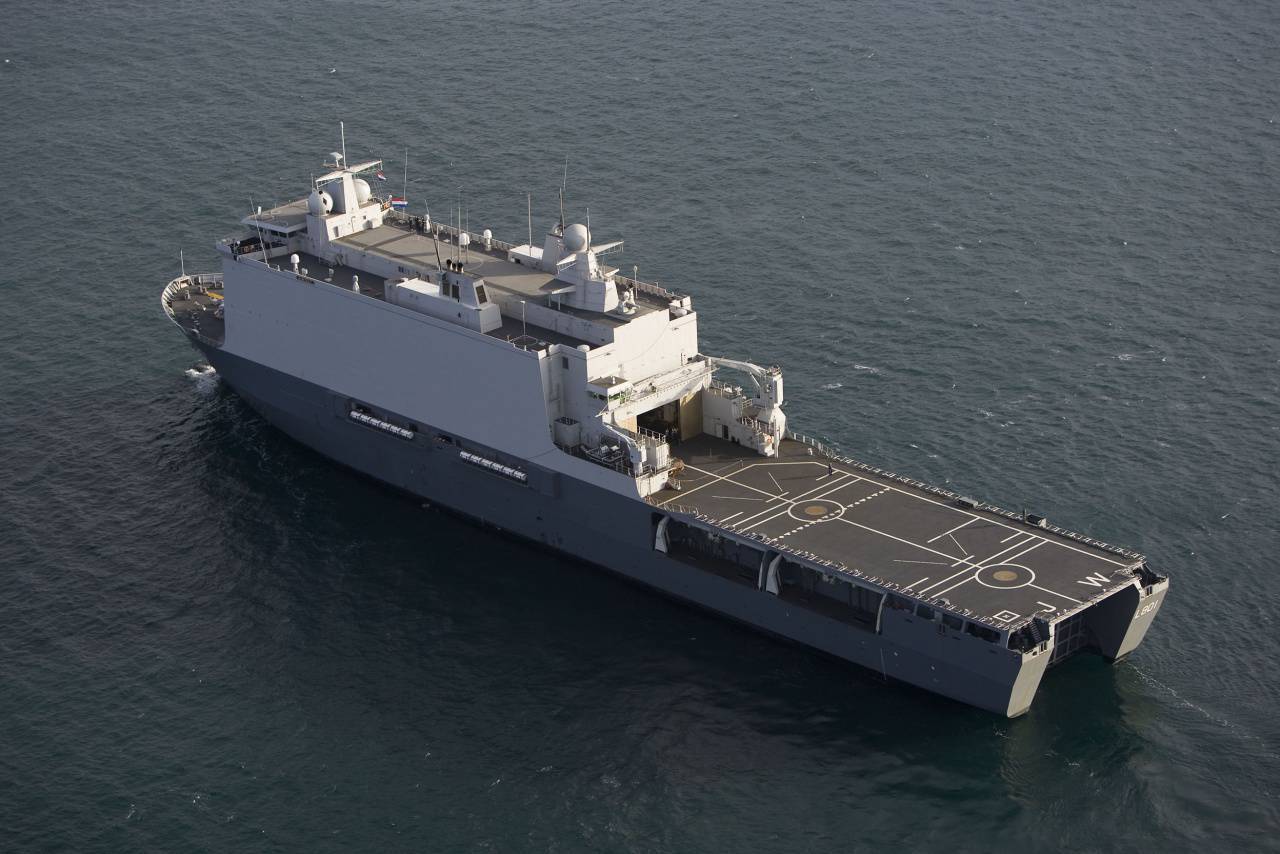
Camera docking area decreased to 575 m. m vacant space was given over to the two decks for the transport of combat and auxiliary equipment of 960 and 1140 m. m In addition, the ship came close compartment for transportation of ammunition total area of 770 square meters. m Cardinal Recycling internal layout of the amphibious assault ship has led to a reduction in space for landing craft. HNLMS Johan de Witt (L801) can carry no more than 2-4 boats, depending on their type. This significantly increased the number of vehicles transported, since the area for its location, in comparison with the ship "Rotterdam", has more than doubled.
For self-landing ship "Johan de Witt" could use two anti-aircraft Thales Netherland SGE-30 Goalkeeper 30 mm caliber heavy machine guns and four M2HB.
On the ship HNLMS Johan de Witt (L801) has a command center with equipment that allows control of naval forces or the Royal Netherlands Navy ship group united NATO.

Ship "Johan de Witt" was laid in June 2003 at a shipyard KMS and launched in March 2005. Completion and testing continued until 2007, after which the ship joined the Navy.
SPS Galicia (L51) and SPS Castilla (L52)
In 1996, the Spanish shipyard Empresa Nacional Bazán (now Navantina) began construction of the first landing ship dock of the new project. Class ships Galicia (the title of head) is largely similar to the Dutch "Rotterdam." Spanish Navy decided immediately to their needs and therefore both types of ship Galicia (SPS Galicia (L51) and SPS Castilla (L52)) were built on the same project without any major changes.
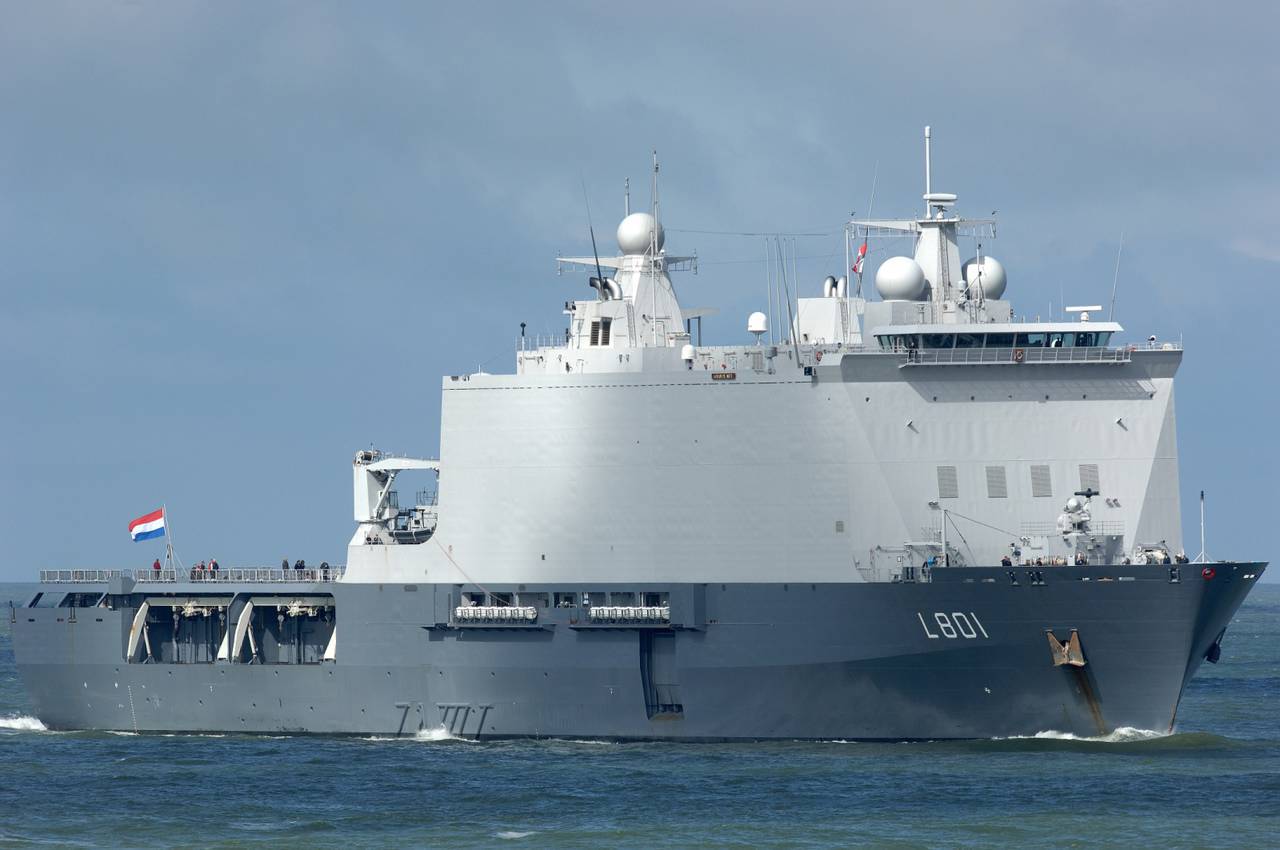
Spanish landing ships docks type of Galicia have a displacement of 13,000 tons at. Ship length - 160 meters, width - 25 m Draft 6,2 m reaches Design "Galicia" and "Castile" similar to that of "Rotterdam." Ships have a large superstructure shifted to the nose, and a flight deck for helicopters at the stern. In the rear of the hull has a volume chamber Dock landing craft for transport of several types. There Kubrick for placing paratroopers and equipment transported to the deck.
Class ships Galicia, on request, have not received a combined power plant using diesel and electric engines. To move the four Spanish ships used Caterpillar 3612 diesel engines with a total capacity of 16.2 MW. Torque is transmitted to the motor shaft with two propellers. This powerplant enables ships to reach speeds up to 20 knots. At a speed of 12 knots cruising range of up to 6,000 miles.

Crew ships SPS Galicia (L51) and SPS Castilla (L52) consists of 115 and 178 people respectively. This difference is due to the fact that the ship "Castilla" in contrast to "Galicia" has two command centers. One of them allows you to command landing operation, and the second is intended to control vehicular connection. On ships has a health unit with two operating theaters, dental surgeries and 10 beds for patients.
For self Galicia class ships carry one 12-barrel anti-aircraft installation Meroka 2B 20 mm caliber. In addition, there are two 20-mm automatic cannon Oerlikon.
Cockpit landing ship "Galicia" in addition to the crew can accommodate up to 540 paratroopers and 70 people from the aviation group. Because of the greater number of his own crew, "Castile" may take on board only 400 Marines. For the storage of weapons and ammunition provided premises with a total area of 205 square meters. Under m flight deck has a hangar 510 m. m hangar is designed to carry 2-4 helicopters 5H-3D, NH-90 and AB-212.
In the rear of the hull has a Camera Dock area of 885 square meters. m At this size, it can accommodate up to eight different types of landing craft. The simultaneous use of different types of landing craft. For transportation of combat vehicles and auxiliary equipment deck has a total area of 1010 square meters. m features allow ships carrying up to 950 tons of equipment, ie about 30 tanks or 130 light armored vehicles.
Construction of the ship SPS Galicia (L51) began in May 1996. The ship was launched in July 1997, and in late April the 98th took part in the Spanish Navy. Ship SPS Castilla (L52) was laid in May 1997. In June '99, the launching of the water, and a year later the ship began service with the Navy.
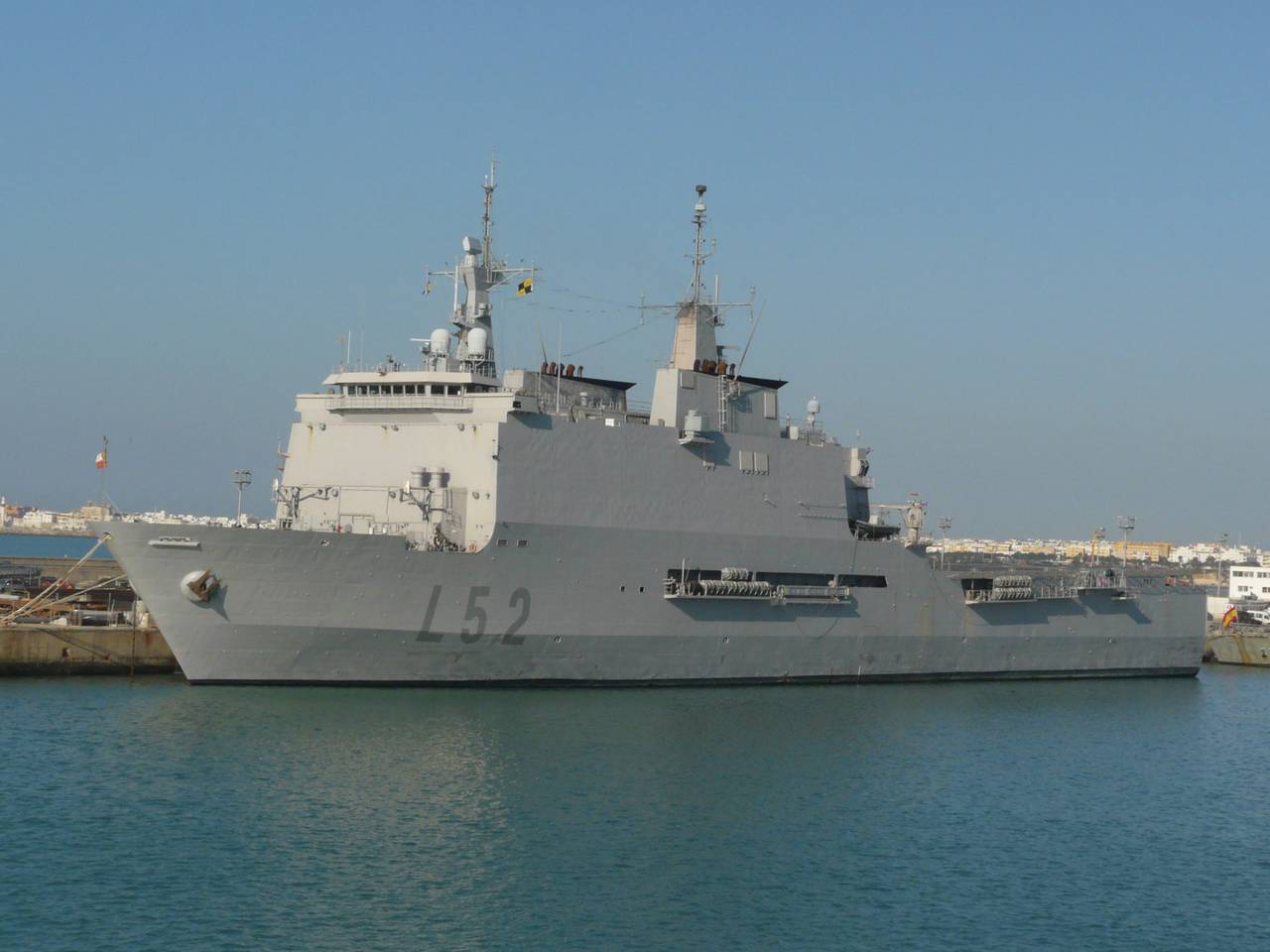
Both ships of the "Galicia" serve at the naval base of Rota in southern Spain. During the years of service they have participated in various exercises. In 2010, the ship SPS Castilla (L52), equipped command centers, became a major participant in the operation "Hispaniola". January 12 on the island of Haiti earthquake. A few days after this command the armed forces of Spain has decided to help the victims. As soon as possible to "Castile" were shipped 4 helicopters, several boats, mobile field hospital, engineering equipment, water purification plants and other equipment necessary to assist the victims. In addition, Haiti went over 450 soldiers and security personnel, as well as 80 doctors. Over the next three months amphibious ship, its crew, boats and helicopters on the various tasks associated with the evacuation of the population and health care.

On this Site:
http://naval-technology.com/
http://military-today.com/
http://seaforces.org/
http://navantia.es/
http://amiinter.com/
=========================
Bagus dan apik bentuk artistik kapalnya.
Mungkin kedua kapal tersebut dapat di pertimbangkan untuk menambah koleksi kapal sejenis yg sudah di miliki TNI - AL, mumpung kondisi kedua negara pemilik kapal tersebut sedang di rundung kesulitan ekonomi.
Siapa tahu berguna untuk keperluan "ferry" MBT kita, apabila akan di deploy di luar pulau Jawa.
Tapi mungkin, .......
Salam.
Spain and the Netherlands several centuries ago were the leading naval powers, but later lost his power. However, they have not lost the desire to develop its naval forces. In the late eighties the two countries agreed on the joint development of new ships for the Navy. In a joint project was supposed to create a promising landing ship dock that meets the navies of the two countries.
Joint project
In developing amphibious ships for the Navy of the Netherlands and Spain comply with the requirements of both parties. While the ships were to have some differences due to the characteristics of their future service and wishes naval command. As a result, despite the common "roots", landing craft docks naval forces of the Netherlands and Spain are markedly different from each other. The names head ships Dutch project was designated Rotterdam-class, Spanish - Galicia-class.

HNLMS Rotterdam (L800)

SPS Galicia (L51)
Construction head ships two projects - HNLMS Rotterdam (L800) for the Netherlands and the SPS Galicia (L51) for Spain - started in the shipyards of the two countries in 1996. Work on the construction came with a fairly high pace and by the middle of 1997, the ships were launched. About a year after it completed testing and leading ships were admitted to the Navy two countries.
The main task of ships of Rotterdam and Galicia is the transportation of troops and providing amphibious landings, with associated basic features of their appearance. All ships built in the framework of the joint project, have a similar layout. Middle and aft of the hull given for placing large docking camera, intended for the carriage of amphibious armored vehicles and landing craft. Large box-shaped superstructure shifted toward the bow. Average and aft deck brought to court for takeoff and landing of helicopters.
Dimensions docking camera, cargo decks and Kubrick lets you carry and provide the-horizon landing battalion of marines with combat and auxiliary equipment. When fully loaded ship HNLMS Rotterdam (L800) is able to carry up to 33 main tanks or armored personnel carriers 170. When transporting a battalion of marines food supplies enough for 10 days of travel.
HNLMS Rotterdam (L800)
Head-dock landing ship for the Royal Netherlands Navy HNLMS Rotterdam (L800) was built on the original project, because of what has smaller dimensions and displacement compared to the next HNLMS Johan de Witt (L801). Ship "Rotterdam" has a length of 166 meters and a maximum width of 25 m Draft - 5.8 meters. Normal displacement of the ship - 12750 tons.

Ship HNLMS Rotterdam (L800) equipped with a combined diesel-electric propulsion. The basis of the power plant are four diesel generator Stork Wärtsilä 12SW28 total capacity of 14.6 MW. Electricity generators supplied by four electric motors with a total capacity of 12 MW. The motors are connected with two propellers, two on each screw. In the bow of the ship has thruster. Such a propulsion system enables amphibious ships of speeds up to 19 knots. Cruising range at economic speed of 12 knots - 6000 miles.
Crew consists of 128 people. In addition, the cockpit for the landing can accommodate more than 600 Marines.
Marine transportation and technology define the layout of the ship. Aft deck are used for takeoff and landing of helicopters. The landing site has dimensions 56h25 meters. There hangar area of 510 square meters. m, designed to carry helicopters. Ship "Rotterdam" can carry and provide work six or four NH90 helicopters EH-101.

Dock camera in the aft hull has a total area of 921 square meters. m This allows you to carry up to six landing craft LCU Mk.II or four LCVP. For transportation of armored vehicles and other equipment ship HNLMS Rotterdam (L800) has a private deck area of 903 square meters. m If necessary, this amphibious assault ship can carry more than 30 tanks and armored personnel carriers to 170.
Dock landing ship "Rotterdam" is solely a defensive weapon. This two anti-aircraft artillery Thales Netherland SGE-30 Goalkeeper 30 mm caliber and four 20-mm automatic cannon Oerlikon.

Bookmark ship HNLMS Rotterdam (L800) was held in late January 1996 at the shipyard in Vlissingen KMS. The ship was launched in the end of February 97th, and in April 1998 became a member of the Royal Netherlands Navy. Since then the ship has participated in various exercises and operations. For example, in spring 2004 the Dutch sailors took part in humanitarian operations in Liberia.
HNLMS Johan de Witt (L801)
During the first few years of service, the lead ship of the project Rotterdam used not only for combat training missions, but also to gain experience operating the new amphibious ships. According to the results of the first years of operation, the fleet command made adjustments to the list of requirements for prospective ships of this class. In June 2003, the ceremony of laying the second ship dock, which proposes to build on the updated project.

The most visible change was the increase in project size and tonnage of the ship. HNLMS Johan de Witt (L801) has a length of 176 meters and a maximum width of 29.2 meters. Precipitate thus decreased to 5.55 m Full displacement increased to 16,680 tons. In connection with the use of new equipment the crew was increased from 128 to 146 people.
The basis of the power plant in the updated draft stayed four diesel generators. Instead of electric motors, two rotating propellers, it was decided to use two azimuth thrusters with motors of 5.5 MW. Thruster in the bow of the ship remained the same. Increase in the size and characteristics of the displacement was compensated updated powerplant. Ship "Johan de Witt" is capable of speeds up to 19.5 knots. Cruising range remained at the lead ship of the project.
Significant changes were made to the deck designed to carry payloads. Despite the increase in the size of the ship, Kubrick for the Marine Corps were reduced. HNLMS Johan de Witt (L801) is capable of carrying not more than 550 fighters with weapons. Dimensions of the flight deck of the new ship increased to 58h25 meters. At the same time were increased hangar whose area is 600 square meters. m It should be noted, as the lead ship of the project, "Johan de Witt" can carry only six medium helicopters or four heavy.

Camera docking area decreased to 575 m. m vacant space was given over to the two decks for the transport of combat and auxiliary equipment of 960 and 1140 m. m In addition, the ship came close compartment for transportation of ammunition total area of 770 square meters. m Cardinal Recycling internal layout of the amphibious assault ship has led to a reduction in space for landing craft. HNLMS Johan de Witt (L801) can carry no more than 2-4 boats, depending on their type. This significantly increased the number of vehicles transported, since the area for its location, in comparison with the ship "Rotterdam", has more than doubled.
For self-landing ship "Johan de Witt" could use two anti-aircraft Thales Netherland SGE-30 Goalkeeper 30 mm caliber heavy machine guns and four M2HB.
On the ship HNLMS Johan de Witt (L801) has a command center with equipment that allows control of naval forces or the Royal Netherlands Navy ship group united NATO.

Ship "Johan de Witt" was laid in June 2003 at a shipyard KMS and launched in March 2005. Completion and testing continued until 2007, after which the ship joined the Navy.
SPS Galicia (L51) and SPS Castilla (L52)
In 1996, the Spanish shipyard Empresa Nacional Bazán (now Navantina) began construction of the first landing ship dock of the new project. Class ships Galicia (the title of head) is largely similar to the Dutch "Rotterdam." Spanish Navy decided immediately to their needs and therefore both types of ship Galicia (SPS Galicia (L51) and SPS Castilla (L52)) were built on the same project without any major changes.

Spanish landing ships docks type of Galicia have a displacement of 13,000 tons at. Ship length - 160 meters, width - 25 m Draft 6,2 m reaches Design "Galicia" and "Castile" similar to that of "Rotterdam." Ships have a large superstructure shifted to the nose, and a flight deck for helicopters at the stern. In the rear of the hull has a volume chamber Dock landing craft for transport of several types. There Kubrick for placing paratroopers and equipment transported to the deck.
Class ships Galicia, on request, have not received a combined power plant using diesel and electric engines. To move the four Spanish ships used Caterpillar 3612 diesel engines with a total capacity of 16.2 MW. Torque is transmitted to the motor shaft with two propellers. This powerplant enables ships to reach speeds up to 20 knots. At a speed of 12 knots cruising range of up to 6,000 miles.

Crew ships SPS Galicia (L51) and SPS Castilla (L52) consists of 115 and 178 people respectively. This difference is due to the fact that the ship "Castilla" in contrast to "Galicia" has two command centers. One of them allows you to command landing operation, and the second is intended to control vehicular connection. On ships has a health unit with two operating theaters, dental surgeries and 10 beds for patients.
For self Galicia class ships carry one 12-barrel anti-aircraft installation Meroka 2B 20 mm caliber. In addition, there are two 20-mm automatic cannon Oerlikon.
Cockpit landing ship "Galicia" in addition to the crew can accommodate up to 540 paratroopers and 70 people from the aviation group. Because of the greater number of his own crew, "Castile" may take on board only 400 Marines. For the storage of weapons and ammunition provided premises with a total area of 205 square meters. Under m flight deck has a hangar 510 m. m hangar is designed to carry 2-4 helicopters 5H-3D, NH-90 and AB-212.
In the rear of the hull has a Camera Dock area of 885 square meters. m At this size, it can accommodate up to eight different types of landing craft. The simultaneous use of different types of landing craft. For transportation of combat vehicles and auxiliary equipment deck has a total area of 1010 square meters. m features allow ships carrying up to 950 tons of equipment, ie about 30 tanks or 130 light armored vehicles.
Construction of the ship SPS Galicia (L51) began in May 1996. The ship was launched in July 1997, and in late April the 98th took part in the Spanish Navy. Ship SPS Castilla (L52) was laid in May 1997. In June '99, the launching of the water, and a year later the ship began service with the Navy.

Both ships of the "Galicia" serve at the naval base of Rota in southern Spain. During the years of service they have participated in various exercises. In 2010, the ship SPS Castilla (L52), equipped command centers, became a major participant in the operation "Hispaniola". January 12 on the island of Haiti earthquake. A few days after this command the armed forces of Spain has decided to help the victims. As soon as possible to "Castile" were shipped 4 helicopters, several boats, mobile field hospital, engineering equipment, water purification plants and other equipment necessary to assist the victims. In addition, Haiti went over 450 soldiers and security personnel, as well as 80 doctors. Over the next three months amphibious ship, its crew, boats and helicopters on the various tasks associated with the evacuation of the population and health care.

On this Site:
http://naval-technology.com/
http://military-today.com/
http://seaforces.org/
http://navantia.es/
http://amiinter.com/
=========================
Bagus dan apik bentuk artistik kapalnya.
Mungkin kedua kapal tersebut dapat di pertimbangkan untuk menambah koleksi kapal sejenis yg sudah di miliki TNI - AL, mumpung kondisi kedua negara pemilik kapal tersebut sedang di rundung kesulitan ekonomi.
Siapa tahu berguna untuk keperluan "ferry" MBT kita, apabila akan di deploy di luar pulau Jawa.
Tapi mungkin, .......
Salam.
0
5.2K
0
Thread Digembok
Thread Digembok
Komunitas Pilihan